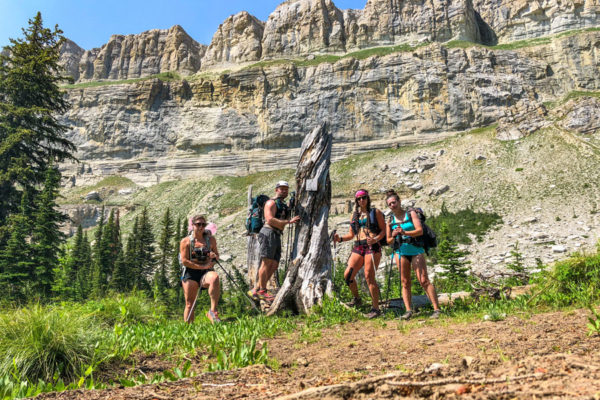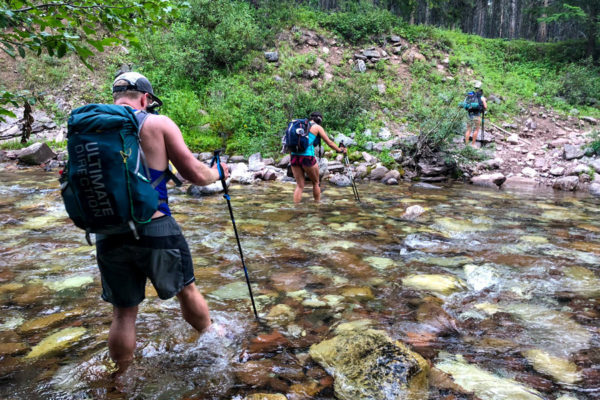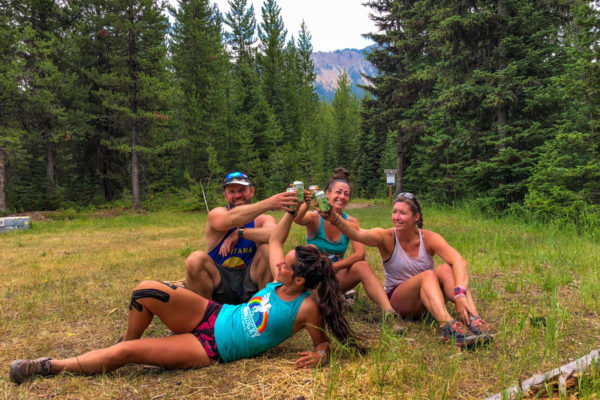For most people, an introduction to the wilderness experience means a hike in the woods for a brief commune with the natural world before returning to the workaday hustle.
But Jenny Dalimata isn’t most people.
Raised barefoot and wild in the mountains of the Nyack Valley near the west entrance to Glacier National Park, Dalimata and her seven brothers grew up exploring the rugged terrain surrounding her family’s ranch, enjoying a degree of freedom that’s become increasingly rarefied in this modern world.
“My dad built our house at the base of Great Bear Wilderness. I could go out the front door and literally just start climbing up into the mountains, into the woods. There were all these game trails and we would go to this place called the Big Rock and track and hunt each other. We had thousands of acres to explore,” Dalimata said, describing a life spent almost entirely in the mountains. “We always had chores to do but we had a lot of time outside, and Dad gave us a lot of freedom. We made fishing poles out of willow branches and bailing twine and we would catch fish. My brothers had a trapline and we developed a really close relationship with the mountains. You had to be strong and self-sufficient even as a kid. You had to be able to make decisions on your own and there was a lot of accountability for yourself and for your siblings. I feel really lucky.”
On one memorable occasion, the family was eating dinner when one of Dalimata’s brothers noticed a big grizzly bear peering through the glass doors and into the dining room.
“That was just part of life. Dad got up from the dinner table and hazed the bear off,” she said. “One time a mountain lion ate my dog on the front porch. The dog’s name was Stupid, but she was a sweetheart.”
Those wild surroundings shaped Dalimata, defining the 33-year-old fourth-generation Montana native’s plucky spirit, steel-like resolve and razor-sharp self-sufficiency. The allure of the mountains has drawn her to hundreds of remote alpine areas and wilderness refuges, by foot, ski and rope. But her entrée to mountain running six years ago opened her eyes to the beauty of moving fast and efficiently over high country, and she began to apply a “run-climb-run” philosophy to her outdoor adventures.

“What really sent it home was this run-climb-run style of mountain running. As far as access goes it just opens up this whole new world. It just changes your whole life. You can be out all day,” Dalimata, who now lives in Bozeman, said. “Running has done a lot for my life in general. Life is tough and running helps with that, it’s really therapeutic, and using it to unlock our wildest places is really special.”
Running can also be a solitary endeavor, and becomes even more isolating when it entails plodding dozens of miles over rugged terrain, getting lost, dodging grizzly bears, popping blisters, enduring dizzying heights, exposure, minimizing chaffage with liberal applications of Body Glide, glissading down scree and snow, squatting in the woods, and drinking from mountain seeps.
So when she divined a six-day running adventure across the Bob Marshall Wilderness Area, she turned to social media to gauge the interest of her followers on Instagram, where Dalimata regularly posts stunning images of her epic treks in the mountains.
“It’s hard to find those people. It can be intimidating. The notion of running long distances being a solitary affair was a big contributing factor of why I wanted to do this trip,” Dalimata said.
Initially, a couple dozen people committed to the run, but in the weeks prior to the planned departure date Dalimata sent out a mass email explaining the logistics and physical condition required for such a trip.
“Even if you’re familiar with distance running, running in the mountains is completely different, so I sent out a come-to-Jesus email just so that everyone had the same expectations,” she said. “Only three people stuck with me.”
Even though the process of attrition whittled down Dalimata’s roster of runners, those who remained would prove to be composed of a steely mettle similar to her own.
Matt Bartkiewicz and Kat Gebauer, both of Whitefish, and Dalimata’s longtime friend and “running wife,” Mary Nolan, a West Glacier native with an unrivaled compulsion to move quickly through high country, committed to running roughly 140 miles and covering 25,000 vertical feet in six days.
“It’s pretty amazing to be from a place where we have these vast wilderness lands and parks and trail systems that are so accessible,” Nolan said. “That is a huge privilege. Not everyone has that access and we have really deep gratitude for that. We don’t want to see it go away.”

While both Gebauer and Bartkiewicz have a respectable resume of long-distance runs and races, neither had spent much time in the Bob, and Gebauer had only been backpacking one time prior to setting out for the group’s six-day adventure — last summer, at Bartkiewicz’s cabin in the Cabinet Mountains.
For Dalimata, who designed the trip to spotlight the importance of protecting public lands, the lack of familiarity with the 1.5 million-acre wilderness complex was perfect, and Gebauer’s inexperience backpacking offered the perfect opportunity for a crash course.
“I try to be a good ambassador to the sport and to our wilderness areas, and I know a lot about traveling in the mountains, how to do overnights, how to navigate and deal with wildlife,” Dalimata said. “I was the new kid once and I had people show me the way. I’m really grateful and I wanted to give back. I wasn’t always a runner but I have always been a mountain person. I just wanted to do something to give back and try and meet some people, because the experiences you have are so powerful in the mountains, and it’s good to share that together. I think it’s good as humans to do something that initiates people into that world.”
Dalimata spent months plotting the course, poring over topographic maps and cobbling together a wilderness run through the heart of the Bob. To complete the trip unsupported, the runners donned packs that weighed between 25 and 30 pounds, and while a friend packed in some basic supplies on their second and final nights, including a bottle of wine and cold soda water, the group carried their own supplies the remainder of the run.
Although Nolan and Dalimata have been running together in the mountains for years, piecing together mountain link-ups and peak enchainments in Glacier National Park and the Absaroka-Beartooth Wilderness near Dalimata’s current home, Gebauer and Bartkiewicz didn’t know the women personally.
To familiarize themselves, they headed to Bozeman to run the Bangtail Divide trail race, a 23.4-mile run through eye-popping mountain terrain. Fresh off a 50-mile ultramarathon, Gebauer was in peak running shape, and Bartkiewicz, a former ultramarathoner who took a hiatus from running after injuring his back, was enjoying a triumphant return to the sport.
“I have dabbled in ultras but I broke my back in 2007 and hadn’t gotten back into it,” Bartkiewicz said. “I decided this summer to start running again, and I did a 50-miler in April and a bunch of other long runs, so I was feeling good. When I heard about the trip Jenny was planning I told Kat about it. We both thought it sounded cool and I like torturing myself, so we decided to do it.”

The foursome struck out on their trip on July 30, starting their run at the East Holland Lake trailhead and immediately climbing 5,000 feet up to an unnamed pass before scrambling down to Necklace Lakes. After more than 26 miles, they arrived at their first campsite at Big Salmon Lake.
“We stopped a lot the first day, adjusting gear and figuring out how to run with the weight of the pack,” Dalimata said. “We got distracted at one trail junction and went a mile-and-a-half out of our way, but on the way we jumped in this fairy pool at Big Salmon Falls. That’s the nice thing about being able to take your time and enjoy the land. It’s not all grueling movement.”
For Bartkiewicz, the day was characterized by brutal blisters, which ravaged his feet after he tied his shoes too tight, swelling a full size. The pain and discomfort would persist the entire trip.
“I was pretty miserable, but you just tape your feet with KT tape, pop the blisters and struggle on,” he said. “I was around such positive people, and being able to see the Bob and appreciate how special it is with other people was amazing.”
Due to the remoteness of the route, the group saw few people, so any encounter was a surprise. The four runners made for a curious spectacle to mule packers and trail workers not accustomed to the sight, and the pink fairy wings Gebauer wore strapped to her back drew special interest.
“We didn’t see a lot of people, and sometimes when you see people in the wilderness you just pass each other by, but when you’re wearing fairy wings everybody wants to talk to you,” Gebauer said.
“There were a lot of creek crossings that we did barefoot because nobody wanted to get their shoes wet,” Dalimata said. “I was waiting on the other side of the river while everyone put their shoes back on, and I decided to do some yoga. I was in the middle of a sun salutation when I looked up and there were these cowboys right there. I think they were confused.”
As the miles added up, the runners fell into a familiar rhythm, refueling, rehydrating, and running for hours on end.

On the third day, the runners went off-route when they climbed up a sub-peak of the Chinese Wall, where they spotted a grizzly bear climbing up and over the pass.
“It was sweet watching him go up and disappear over the pass, but we got enchanted and lost our route. We ended up on top of the Chinese Wall and had to traverse back to the trail, but it was worth it,” Dalimata said.
For Dalimata, her favorite day, the fourth, was also the longest and most grueling, but tracking along the Continental Divide along a rock-reef wall that glowed golden was a highlight she won’t forget. They’d end up running nearly 30 miles that day in more than 13 hours, but the day’s terminus at Trilobite Lakes made it worth the suffering.
On the fifth day, the route ran them into the Great Bear Wilderness, where views of the Middle Fork Flathead River valley swung into view, and Dalimata was overcome with emotion looking out over her home range.
“I have been pretty homesick and this route I made literally had me running home to the Middle Fork,” she said. “It was a super powerful moment. It brought me to tears. Those are my home mountains and seeing familiar shape and the geology filled me with this sense of returning home. You just know that you belong there and it felt really good to return to that place, especially when you’re on one of the last days of this dream journey that you have been thinking about for years and it’s just this incredible sense of fulfillment. I was laughing and crying and screaming with joy.”

The group spent their final night at Schafer Meadows and their final food drop. Bartkiewicz grilled a steak dinner with fresh veggies and cold beer. The final day was a roughly 17-mile push out to Granite Creek Trailhead and Dalimata’s car, signaling the end of the trip and the re-entry to civilization.
“We saw these fishermen at one of the last creek crossings. We were quite a sight. Mary was running in her underwear, I had feathers sticking out of my hair and Kat had these torn-up, dirty fairy wings on her back,” Dalimata said. “Finishing was a mix of emotions, but it was so fulfilling to have experienced the Bob this way. I really hope more people will explore it and appreciate the level of access we enjoy here.”
